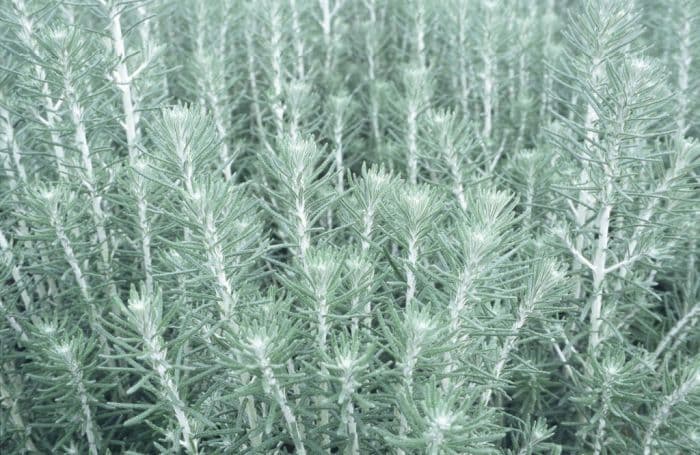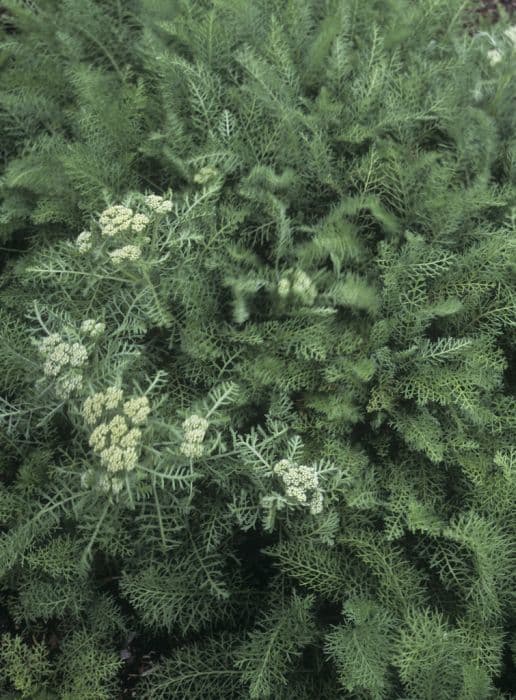Ozothamnus 'Silver Jubilee' Ozothamnus rosmarinifolius 'Silver Jubilee'

ABOUT
'Silver Jubilee' is an upright evergreen shrub with rosemary-like, linear, silvery-grey leaves and compact clusters of scented white flower-heads from red buds, in dense terminal clusters
About this plant
 Names
NamesFamily
Asteraceae.
Synonyms
Sea Rosemary, Rosemary Ozothamnus, Silver Jubilee Everlasting.
Common names
Helichrysum rosmarinifolium, Ozothamnus rosmarinifolius, Helichrysum obcordatum.
 Characteristics
CharacteristicsLife cycle
Perennials
Foliage type
Evergreen
Color of leaves
Silver-green
Flower color
White
Height
2-3 feet (60-90 cm)
Spread
2 feet (60 cm)
Plant type
Shrub
Hardiness zones
7
Native area
Australia
Benefits
 General Benefits
General Benefits- Ornamental Appeal - Adds visual interest to gardens with its silvery foliage and white flowers.
- Drought Tolerance - Once established, it is quite resistant to drought, making it suitable for xeriscaping.
- Low Maintenance - Requires minimal care beyond basic watering and occasional pruning.
- Evergreen Nature - Maintains foliage throughout the year, providing constant greenery in gardens.
- Wildlife Attraction - Attracts bees, butterflies, and other pollinators with its flowers.
- Soil Adaptability - Adapts to a range of soil types, though it prefers well-draining soil conditions.
- Hardy Plant - Demonstrates a good level of resistance to cold temperatures, surviving in many climates.
 Medical Properties
Medical PropertiesThis plant is not used for medical purposes.
 Air-purifying Qualities
Air-purifying QualitiesThis plant is not specifically known for air purifying qualities.
 Other Uses
Other Uses- Ozothamnus rosmarinifolius 'Silver Jubilee', commonly known as sea rosemary, can be used in dried floral arrangements due to its long-lasting small, silvery-white blooms.
- Sea rosemary can serve as an excellent foil for more colorful plants in a mixed border, contributing its silver foliage to the overall aesthetic.
- Due to its bushy growth habit and dense foliage, sea rosemary is suitable for creating low, informal hedges or garden borders.
- With its tolerance to salt spray, sea rosemary can be used in coastal gardens to help stabilize sand and prevent erosion.
- Its drought resistance makes sea rosemary a sensible choice for xeriscaping or rock gardens in arid or semi-arid regions.
- Sea rosemary can be interplanted with perennials and grasses to serve as a contrasting foliage plant in texture and color, especially in sensory gardens.
- Its long-lasting blooms and attractive to butterflies and bees, making it a suitable planting choice for pollinator-friendly gardens.
- Sea rosemary can be used as a potted plant on patios or balconies for its decorative silver foliage and low maintenance needs.
- When planted en masse, sea rosemary can be utilized as ground cover to provide a silver blanket effect in landscape design.
- The woody stems of sea rosemary can be used in crafts or as natural support stakes for other plants in a garden.
Interesting Facts
 Feng Shui
Feng ShuiThe plant Sea Rosemary is not used in Feng Shui practice.
 Zodiac Sign Compitability
Zodiac Sign CompitabilityThe plant Sea Rosemary is not used in astrology practice.
 Plant Symbolism
Plant Symbolism- Hardiness: Ozothamnus rosmarinifolius 'Silver Jubilee', commonly known as the Sea Rosemary, is recognized for its ability to thrive in tough conditions, symbolizing endurance and resilience.
- Evergreen Nature: Being an evergreen plant, Sea Rosemary represents eternal life and constancy.
- Healing: Traditionally, rosemary, which Sea Rosemary resembles in foliage, has been associated with healing properties, so this plant can symbolize health and recovery.
- Remembrance: Rosemary is historically known for its role in remembrance. Sea Rosemary could therefore carry a symbol of memory and tribute to the past or loved ones.
- Celebration: The 'Silver Jubilee' cultivar may symbolize celebration, marking a significant milestone or anniversary, as a jubilee is a commemorative event.
- Purity and Innocence: The silver to white flowers of the Sea Rosemary may evoke feelings of purity and innocence, similar to the symbolism of white blooms in general.
 Water
WaterFor the Sea Rose, also known as Ozothamnus rosmarinifolius 'Silver Jubilee', it is vital to establish a watering routine that considers the plant's preference for well-drained soils and semi-arid conditions. Water the Sea Rose deeply but infrequently, allowing the soil to dry out between waterings. In general, aim for approximately one gallon of water per week, adjusting for rainfall and temperature, which may increase the plant's water needs during hot, dry periods. During winter or cooler months, reduce the amount of water to prevent root rot.
 Light
LightThe Sea Rose thrives best in full sun exposure where it can receive at least six hours of direct sunlight daily. It is well-suited to a spot in the garden that is open and not shaded by taller plants or structures, as ample sunlight is crucial for its growth and flower production.
 Temperature
TemperatureThe Sea Rose prefers temperate climates and can survive in temperatures ranging from 20°F to 90°F, but it thrives best in the range of 60°F to 80°F. While the plant is frost-tolerant, prolonged exposure to severe cold below 20°F can damage or kill the plant, so it is essential to provide protection or consider moving it to a sheltered location if extreme cold is expected.
 Pruning
PruningPruning the Sea Rose is mainly done to maintain its shape and encourage dense growth. Prune lightly in the late winter or early spring before the new growth starts. This helps to remove any dead or damaged stems and promotes a robust flush of new growth. Additionally, you can deadhead spent flowers to encourage further blooming.
 Cleaning
CleaningAs needed
 Soil
SoilSea rosemary grows best in a well-drained, sandy to loamy soil with a pH between 6.0 and 7.5. A mix of 1/3 sand, 1/3 garden soil, and 1/3 compost or peat can create ideal conditions. Avoid waterlogged environments to prevent root rot.
 Repotting
RepottingSea rosemary plants should generally be repotted every 2 to 3 years to refresh the soil and accommodate root growth. It's best to repot in spring or early summer before the peak growth period.
 Humidity & Misting
Humidity & MistingSea rosemary thrives in moderate to low humidity environments and does not require high humidity to grow healthily. Average indoor humidity levels are typically adequate for this plant.
 Suitable locations
Suitable locationsIndoor
Bright indirect light and well-draining potting mix are essential for growing sea rosemary indoors.
Outdoor
Plant in full sun to partial shade, well-draining soil; protect from harsh winter.
Hardiness zone
8-10 USDA
 Life cycle
Life cycleOzothamnus rosmarinifolius 'Silver Jubilee', commonly known as Sea Rosemary, begins its life cycle as a seed, which upon germination develops into a seedling with basic root, stem, and leaf structures. As it grows, the seedling enters the vegetative stage, where it develops a robust woody stem and needle-like leaves, characterized by their silver-gray foliage. During the flowering stage, typically in spring or summer, Sea Rosemary produces clusters of small, button-like white or cream flowers, which are attractive to pollinators. After pollination, the flowers develop into fruits that release seeds, completing the reproductive cycle. The plant reaches maturity within a few years, at which point it can be pruned to maintain its shape and encourage denser growth. Sea Rosemary is a perennial shrub and can live many years, going through cycles of growth, flowering, and seed production annually.
 Propogation
PropogationPropogation time
Spring-early summer
Propogation: Ozothamnus rosmarinifolius 'Silver Jubilee', commonly known as Sea Rosemary, is typically propagated by semi-hardwood cuttings. This popular method involves selecting healthy, semi-ripe stems from the current season's growth in late summer to early fall. Cuttings should be about 4 to 6 inches (approximately 10 to 15 centimeters) long and have several leaves. The lower leaves are removed, and the base of the cutting is dipped in a rooting hormone to encourage root development. The prepared cuttings are then inserted into a well-draining propagation medium such as a mix of perlite and peat. They should be placed in a warm, humid environment, but out of direct sunlight, and kept moist until roots have developed, which usually takes several weeks. Once rooted, the new plants can be gradually acclimatized to outdoor conditions before being planted out in their final positions.









